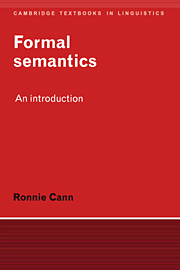Book contents
- Frontmatter
- Contents
- List of figures
- Preface
- List of symbols
- 1 INTRODUCTION
- 2 PREDICATES AND ARGUMENTS
- 3 NEGATION AND CO-ORDINATION
- 4 TYPE THEORY
- 5 THE LAMBDA OPERATOR
- 6 QUANTIFICATION
- 7 INFERENCE
- 8 TIME, TENSE AND ASPECT
- 9 POSSIBLE WORLDS
- 10 INTENSIONAL SEMANTICS
- Answers to selected exercises
- References
- Index
3 - NEGATION AND CO-ORDINATION
Published online by Cambridge University Press: 05 June 2012
- Frontmatter
- Contents
- List of figures
- Preface
- List of symbols
- 1 INTRODUCTION
- 2 PREDICATES AND ARGUMENTS
- 3 NEGATION AND CO-ORDINATION
- 4 TYPE THEORY
- 5 THE LAMBDA OPERATOR
- 6 QUANTIFICATION
- 7 INFERENCE
- 8 TIME, TENSE AND ASPECT
- 9 POSSIBLE WORLDS
- 10 INTENSIONAL SEMANTICS
- Answers to selected exercises
- References
- Index
Summary
Compound sentences
The grammar presented in Chapter 2 generates some very basic sentences of English and the translation procedure enables each one to be associated with at least one representation in Lp (more than one, if it contains a homonym). While the number of sentences generated by the grammar, G1 is relatively large (and can be made larger if more words are added to the lexicon), the language it generates is still finite. One of the properties that all natural languages are assumed to have is that they contain an infinite number of sentences. Since one of the goals of a theory of semantics, as we saw in Chapter 1, is to pair each sentence in a natural language with an interpretation, the theory must contain the means to provide an infinite number of interpretations. Furthermore, because natural languages are here being interpreted indirectly via a logical representation, the logical translation language must itself be infinite.
The reason that natural languages are infinite is that they are recursive. This means that expressions in certain categories may contain other expressions of the same category. For example, sentences may contain other sentences conjoined by the expressions and or or, or they may be connected by if…then, or a sentence may contain one or more repetitions of the expression it is not the case that. Some examples based on the grammar G1 are given in (1).
- Type
- Chapter
- Information
- Formal SemanticsAn Introduction, pp. 54 - 81Publisher: Cambridge University PressPrint publication year: 1993



